What is the Name of this Tree?
It is time for another question of the week. What is the name of this tree? is it a native? Answer will be posted below the pictures next week !
Many fertilizers are available in the stores and promotions are everywhere that state that now is the time for lawns to be winterized. Applications of nitrogen after mid September can lead to turf problems next spring. Nitrogen encourages growth of the grass which uses up stored food. As the weather frequently changes throughout the winter months, grasses may use up their food reserves and not have enough carbohydrates to regrow when weather consistently warms next year.
Besides creating unnessary new growth as grasses enter winter dormancy, lawns receive additional stresses when gardeners add nitrogen this late in the season One such issue with a late season application of nitrogen is that it can make the grass more susceptible to large patch fungus. This fungus is active when soil temperatures range between 75 and 65 degrees F. Nitrogen applications encourage lush growth which can increase the incidence of the disease.
For those that feel it necessary to apply some type of fertilizer now, potassium may be applied for the next couple of weeks. Potassium is often sold as a 0-0-60 and the rate is about 1.5 lbs. of the fertilizer per 1,000 square feet of lawn.
Learn much more about lawn fertilization from the University of Florida IFAS Extension.
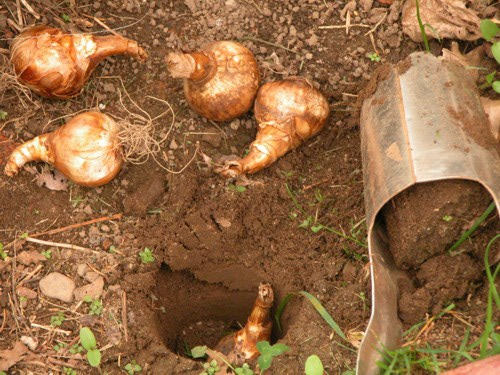
Gardeners may wonder why spring flowering bulbs are a timely topic now when fall is tip-toeing in, but as with most things in horticulture, there is a method to the madness. While many gardeners have become accustomed to running out to the local garden center and buying flats or pots of blooming bedding plants to create “instant gardens”, this last-minute approach simply does not and will not work when spring-flowering bulbs are desired in the landscape. So procrastinators beware! If beautiful beds of daffodils, tulips or Dutch irises are wanted next spring, now is the time to act, not next spring when everyone else’s are blooming.
Spring-flowering bulbs are generally defined as those that bloom here in north Florida between February and April. Information is available dividing these bulbs into categories based on when they bloom in the spring – such as very early, early, mid-season, late and very late. This will allow the garden to be in flower over a longer period during the season.
When buying bulbs, purchase the highest quality stock possible. The quality of the bulb correlates directly to the quality of the blooms. Selecting loose bulbs at a local garden center is like choosing produce at the supermarket. Pick the largest, plumpest bulbs that are firm with no obvious cuts, soft spots or rot. When ordering from a catalog, do it as soon as possible and generally choose the larger sizes when offered.
Choose selections wisely as the flowers of many bulbs do not last an especially long time. For example, while a tulip is a great bulb and an extremely attractive flower, it produces one flower that lasts about seven to ten days and then just like that, it’s done. Ranunculus, on the other hand, can bloom over a four- to six-week period. One thing to expect across the board, however, is the price for color from bulbs is going to be higher than for longer-flowering cool-season bedding plants like pansies and dianthus. If gardening budgets are limited, use spring bulbs more for embellishment and let cool season bedding plants provide the primary floral display.
Obtaining a nice display of spring flowering bulbs depends upon where and how they are planted. Good drainage, part to full sun and moderately fertile soil are all that are needed for bulbs to do well. The average landscape bed generally provides adequate drainage, but avoid low spots that tend to stay moist as this will cause bulbs to rot in a hurry. If drainage is in doubt, plant in raised beds. Choose a spot where there is some shade from the afternoon sun, this allows the flowers to last a little longer, especially if the spring weather turns warm.
It is important to plant bulbs at the proper depth. A rule of thumb is to plant bulbs at a depth equal to twice their height. This far south we generally don’t plant bulbs quite as deep as standard recommendations. Smaller bulbs are planted about 1 or 2 inches deep while larger bulbs are planted about 5 inches deep. Dig individual holes the proper depth, or excavate out, the area to be planted, to the recommended depth and plant all of the bulbs at once.
Once the bulbs are in the ground, plant over them with low growing cool season annuals, such as alyssum, violas, lobelia or pansies. Be careful not to disturb the bulbs. The annuals cover the bare soil and provide color before, during and after the bulbs bloom. Make sure the bulbs will produce blooms that are taller than the annuals, and make sure the colors of the annual flowers contrast with or compliment the flowers of the bulbs in a pleasant way.
Although the proper time to plant most bulbs is October and November, there are a couple of notable exceptions. Tulips and hyacinths will perform much better if they are refrigerated at least six weeks in the vegetable bin of your refrigerator prior to planting (storing longer than six weeks is better) starting now. Store them in paper or net bags (well labeled.) The paper or net allows excellent air circulation that in turn will decrease rot. Avoid storing them near apples and other fruit as these fruit produce a plant hormone called ethylene that can severely alter everything from the time a bulb will bloom to shape, to survival. Plant them in late December or early January when the soil has had a chance to get cold.
Many of the spring bulbs available locally or in catalogs will only bloom reliably for us their first year. Some of the favorites include: tulip, grape hyacinth, crocus, hyacinth, ranunculus, anemone, scilla, freesia, ixia, sparaxis and ornithogalum.
The following are some of the spring bulbs that tend to be reliably long-lived in north Florida and should bloom for several years at least: Narcissus cultivars such as paperwhites, Chinese Sacred Lily, Soleil d’Or, Grand Primo, Cheerfulness, jonquils, Sweetness, Trevethian, Peeping Tom, February Gold, Thalia, Ice Wings, Petrel and larger flowered daffodil cultivars such as Ice Follies, Unsurpassable, Carlton and Fortune.
Other reliable re-blooming bulbs include snowflake (Leucojum aestivum), some flowering onions (Allium neapolitanum, Allium drummondii), ground orchid (Bletilla striata), amaryllis (Hippeastrum species and hybrids), Spanish bluebells (Hyacinthoides hispanica), spring star flower (Ipheion uniflorum), Dutch iris (Iris x hollandica) and Easter lily (Lilium longiflorum).
You can also find an excellent publication written by Dr. Gary Knox on low maintenance bulbs at UF IFAS Extension’s EDIS website.
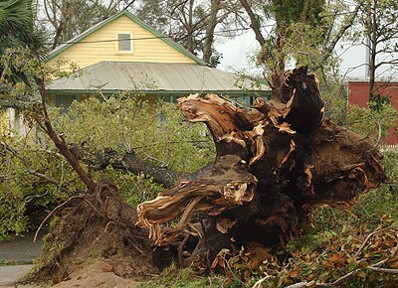
After severe weather of any kind, homeowners must often spend a considerable amount of time dealing with impacts to their landscapes. Below are a few lessons we have learned from hurricanes and tropical storms in the past. Many thanks to fellow agent Beth Bolles for her contributions to this article.
Dealing with Toppled Trees
It may be difficult to turn an uprooted favorite tree into firewood, but this is probably the best choice. A small or young tree may be replanted successfully if done immediately. These trees will require bracing for up to two years until the root systems regrow and are able to support themselves. If the roots have been exposed for an extended period of time, don’t try and save the tree. Exposed roots should be covered with soil or moist burlap for protection from drying out. Large or older trees will typically not survive this ordeal even with the best of care. Because the root system is compromised, attempting to keep the tree may create a hazard down the road with the next storm.
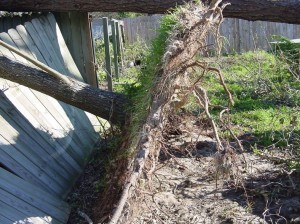
If a tree is completely uprooted, its odds of recovery are severely limited and it is best to remove the tree. Photo courtesy Beth Bolles, UF IFAS Extension
When removing fallen trees, think ahead about whether you plan to remove stumps. It’s a lot easier to pull instead of dig stumps out of the ground, so leave a four-foot stump to make your life easier. Be careful using power equipment like chain saws. It may be better to hire a professional to deal with removing large trees, especially around power lines.
Exposed Roots or Leaning Trees
Any exposed roots should be covered immediately. Cover roots with nearby soil at the same level roots were originally growing. Do not bank the soil higher because this will cut off oxygen supplies to roots in an already oxygen deprived, saturated soil.
If small trees are leaning and need straightening, they can be staked and treated like a newly planted tree. Larger trees with trunks greater than six inches in diameter can be saved but should be removed if they are a hazard to structures, power lines, or roadways. Reset the trees with stakes or guy wires for support. Trees with trunks measuring less than two inches in diameter can be supported with two or three forty-eight inch, two inch by two inch wood stakes placed one foot outside of the root ball inserted eighteen inches into the ground. Larger trees should be anchored with three or four guy wires or cables. Cover guy wires that are in contact with the trunk with rubber hoses to prevent damage.
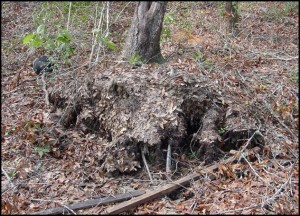
A leaning, partially uprooted tree may recover if it is righted and its roots are covered back with soil. Photo courtesty Beth Bolles, UF IFAS Extension
Replace the soil around the area and firm to assure there are no air pockets around the roots. Make sure the top root coming off the trunk is level with the existing soil. If many trees were swaying back and forth during the wind, there may be air pockets underneath the trees. If this is obvious, add soil and water to eliminate any air pockets. If root damage is obvious, do not fertilize at this time because salts in the fertilizer may damage new feeder roots.
Broken Branches
Broken branches should be removed from trees and shrubs as soon as possible to prevent tearing into trunk wood. Make clean cuts just outside of the branch collar to avoid damaging the trunk. If these are large branches, make three separate cuts to prevent tearing. Make the first cut on the underside of the branch about fifteen inches from the trunk and one-third through the branch. The second cut is made from the top, a few inches out from the first cut. This cut should remove the weight of the branch so the next one will not rip the trunk. The remaining stub can be held while the last cut is made. Make the last cut just outside the branch bark ridge and end outside the trunk collar (swollen area on lower side of branch). This is not a flush cut with the trunk and should leave a small protrusion on the trunk. Do not use wound dressing on the cut surface, as this practice is no longer recommended.
If trees lost all of their branches, it is advisable to remove the tree. The natural shape is gone and trees like pines will typically not recover. Some trees may lose the majority of their leaves, but these will flush back out so they should be okay.
Repairing Lawns
Keep a close eye on lawns for disease problems due to all the rain. Brown patch and take-all root rot would be the major concerns. Rake and remove all debris to give lawns a chance to dry out. If lawn areas are damaged, now is the time to replace with plugs or sod so they can establish before winter. Sod webworms are bad now so don’t mistake this damage for diseases. If adult moths are obvious and grass blades are closely cropped, this is due to caterpillar damage…not disease.
Watering
Most soils are saturated and irrigation systems should be in the off-mode. If there is standing water around trees or in other low areas, use a hose to siphon water to a retention pond or a better-drained area. Once soils dry out and the sun comes out, keep a close eye on plants as they may require more frequent irrigation because of root damage. Coastal areas flooded with saltwater may experience damage from extended exposure to high salinity; it is recommended to run a sprinkler system to flush out a lawn after the water retreats.
If you have questions, contact your local UF IFAS Extension Office!
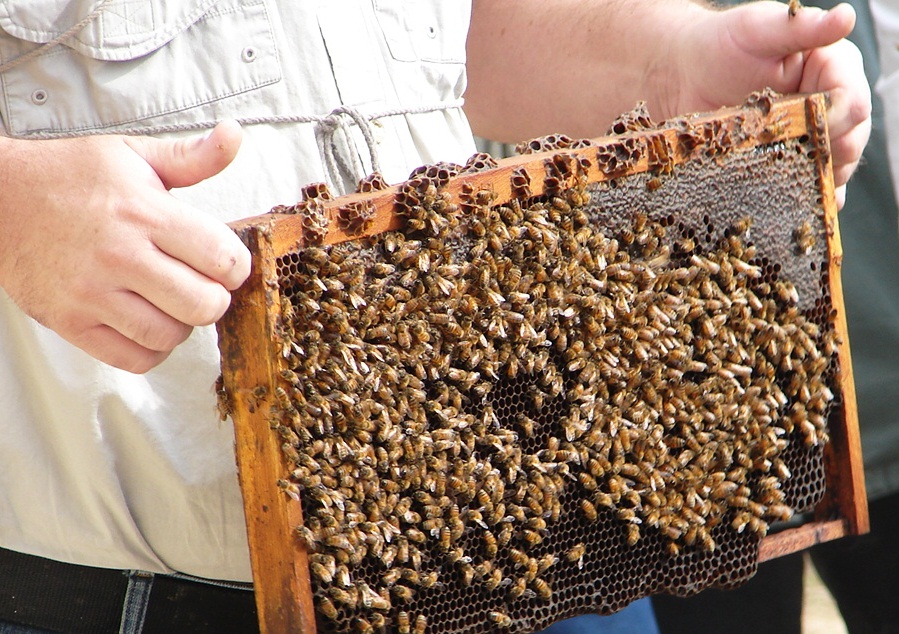
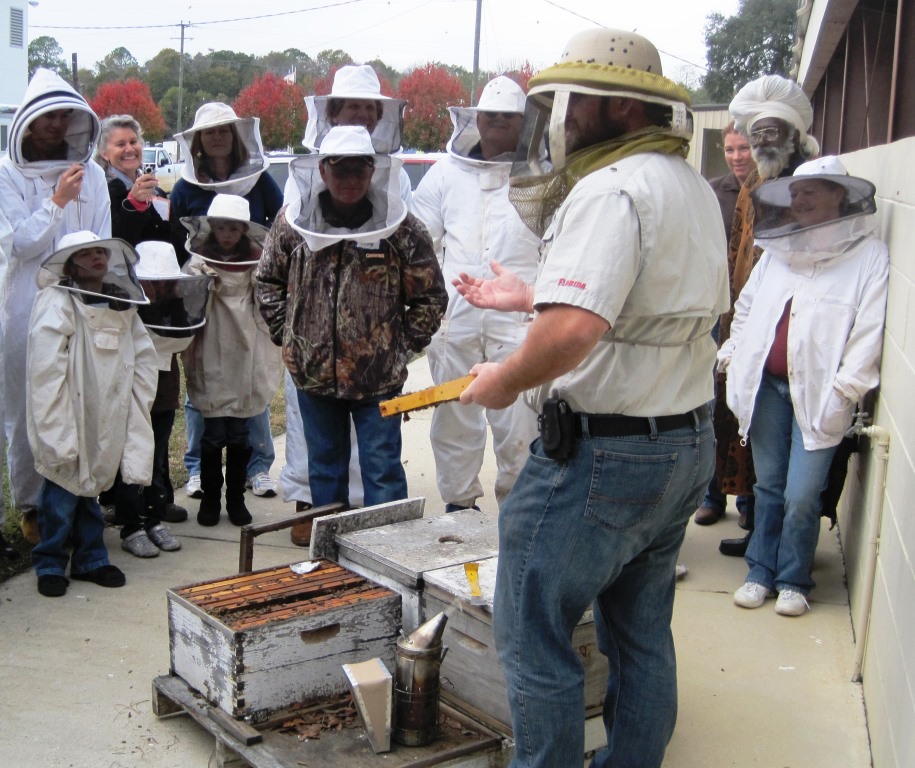
The Beekeeping trade-show will provide beekeepers of all skill levels and ages a chance to interact with entomologists, beekeepers, real bee hives, and beekeeping equipment vendors.
The third annual UF/IFAS Beekeeping Field day and Trade-show is proud to be part of the 2013 Florida State Beekeepers Association Meeting in Chipley Florida. This trade-show event will provide educational opportunities through hands-on activities and interaction with expert beekeepers and vendors for hundreds of local beekeepers. Beekeepers with all levels of experience are encouraged to attend!
The Day’s Agenda: (8:30 – 2:30 Central Time Zone)
Topics at the Trade-show and Field day include:
Registration:
Bay County 850-784-6105 Jefferson County 850-342-0187
Calhoun County 850-674-8323 Leon County 850-606-5202
Escambia County 850-475-5230 Liberty County 850-643-2229
Franklin County 850-653-9337 Okaloosa County 850-689-5850
Gadsden County 850-875-7255 Santa Rosa County 850-623-3868
Gulf County 850-639-3200 Wakulla County 850-653-9337
Holmes County 850-547-1108 Walton County 850-892-8172
Jackson County 850-482-9620 Washington County 850-638-6180
A detailed workshop agenda is just a “click” away at this link: Beekeepers Field Day And Trade Show 2013